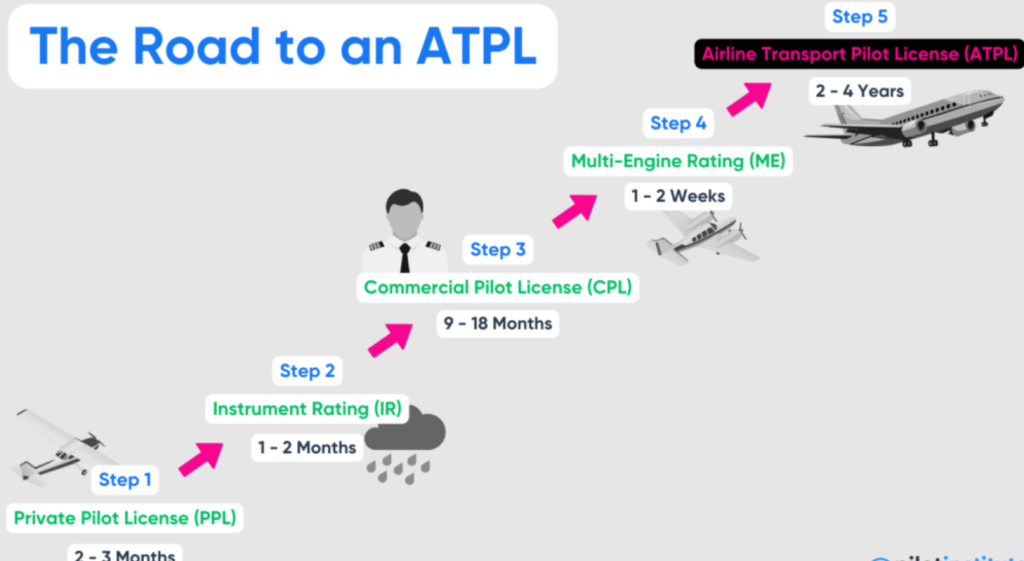
A Commercial Pilot License (CPL) is a type of pilot license that allows the holder to fly an aircraft for compensation or hire. It is the first level of pilot license that allows pilots to fly for commercial purposes. To obtain a CPL, pilots must meet certain requirements, including:
- Be at least 18 years old
- Hold a valid Private Pilot License (PPL)
- Complete a minimum of 250 hours of flight time, including 100 hours as pilot in command
- Pass a written exam and a practical flight test
In addition to the above requirements, pilots must also meet certain medical standards. Pilots must have a valid Class 1 medical certificate, which is the highest level of medical certification for pilots.
The cost of obtaining a CPL varies depending on the flight school and the location. In general, it costs between $50,000 and $100,000 to obtain a CPL.
With a CPL, pilots can fly for commercial airlines, charter companies, or even start their own businesses. They can also fly for non-profit organizations, such as air ambulance services.

Here are some of the benefits of having a CPL:
- The ability to fly for compensation or hire
- The ability to fly larger and more complex aircraft
- The ability to work as a commercial pilot for an airline or charter company
- The ability to start your own business as a pilot
If you are interested in becoming a commercial pilot, there are a few things you can do to get started:
- Do your research and find a reputable flight school.
- Talk to other pilots and get their advice.
- Start saving money for flight training.
- Get in good physical condition.
Becoming a commercial pilot is a challenging but rewarding career. If you are passionate about flying, a CPL can be the first step to a fulfilling career in aviation.

A Commercial Pilot License (CPL) is a specialized pilot’s license that allows individuals to operate aircraft for compensation or hire. In other words, holders of a CPL can be paid for their services as pilots. This type of license is a significant step beyond a private pilot license and represents a higher level of training, experience, and qualifications. Here are key points about a Commercial Pilot License (CPL):
- Eligibility: To qualify for a CPL, individuals must meet specific requirements, which can vary by country and aviation authority. Common eligibility criteria include:
- Being at least 18 years old.
- Holding a private pilot license.
- Accumulating a minimum number of flight hours (typically around 250 hours in many cases).
- Passing a series of written exams covering aviation knowledge.
- Meeting medical fitness requirements.
- Training: CPL candidates undergo comprehensive training that includes both ground school instruction and flight training. This training covers advanced flight techniques, navigation, aerodynamics, emergency procedures, and more.
- Flight Hours: CPL candidates are required to accumulate a specified number of flight hours, which includes solo and dual flight time. These hours go beyond the flight hours required for a private pilot license.
- Theory Examinations: Candidates must pass written examinations that assess their knowledge of aviation regulations, meteorology, navigation, aircraft systems, and related topics.
- Checkrides: To earn a CPL, candidates must pass a practical flight test, commonly known as a checkride. During the checkride, a certified flight examiner evaluates the candidate’s flying skills, decision-making abilities, and proficiency in handling various flight scenarios and emergencies.
- Privileges: Once awarded a CPL, pilots are permitted to operate aircraft for commercial purposes. They can work as commercial airline pilots, cargo pilots, charter pilots, flight instructors, and in other aviation-related roles. They can receive compensation for their piloting services.
- Continuing Education: Commercial pilots are encouraged to engage in ongoing education and training to stay up-to-date with industry standards and regulations. Continuous learning is crucial to maintaining and advancing their careers.
- Airline Transport Pilot License (ATPL): For those aiming to become airline captains, the next step after obtaining a CPL is often pursuing an Airline Transport Pilot License (ATPL). An ATPL is the highest level of pilot certification and is required for command roles on large commercial aircraft.

